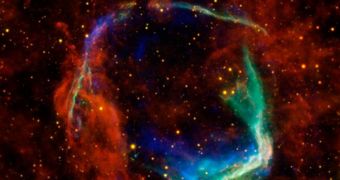Using the NASA Spitzer Space Telescope, astronomers were recently able to answer some of the most difficult questions related to the supernova RCW 86. Chinese astronomers were the first to detect it in 185 AD, and the object is widely accepted as the oldest documented supernova event.
In the new investigation, experts used data from Spitzer and the NASA Wide-field Infrared Survey Explorer (WISE) telescope to look at the object. They were able to determine how the event occurred, and how the supernova remnant spread afterwards.
One of the main issues astronomers had trouble explaining was how material from this exploded star traveled so fast over such great distances. The two NASA telescopes revealed that the stellar explosion took place in a hollow cavity, which means that the material did not meet any resistance as it spread.
According to historical records, RCW 86 appeared in the night sky in 185 AD, and remained visible for about 8 months. The Chinese astronomers who discovered it called it a “guest star,” which must have seemed appropriate at the time.
It wasn't until the 1960s that experts were able to discover the supernova remnant the old explosion had left behind. The structure is located about 8,000 light-years away, which is relatively close in astronomical terms.
“This supernova remnant got really big, really fast. It's two to three times bigger than we would expect for a supernova that was witnessed exploding nearly 2,000 years ago. Now, we've been able to finally pinpoint the cause,” scientist Brian J. Williams explains.
The expert – who holds an appointment as an astronomer at the North Carolina State University (NCSU), in Raleigh – was also the lead author of a study detailing the findings, which appears in the latest online issue of the esteemed Astrophysical Journal.
With the help of older data collected by the NASA Chandra X-ray Observatory and the European Space Agency's (ESA) XMM-Newton Observatory, the team was able to find that RCW 86 was in fact a Type Ia supernova.
This means that its precursor was a white dwarf that itself formed after a Sun-like star reached the end of its burning cycle. However, unlike our parent star, this one was in a binary system, so the white dwarf began accreting mass from its companion.
After eons of feeding, the object finally grew so large that it exceeded its stability limit. When this happened, the object detonated in a powerful thermonuclear explosion, which is precisely what the Chinese astronomers saw.
“A white dwarf is like a smoking cinder from a burnt-out fire. If you pour gasoline on it, it will explode,” Williams concludes.

 14 DAY TRIAL //
14 DAY TRIAL //